
HENOLOGY: KNOW THY HEN FOR SHE IS GREAT
YOUR CHICKENS ARE FUN and curious family members and friends. If starting your first flock, have faith that your chickens will become your homegrown guide to enjoying your own backyard. Many people with chickens learn to see a common backyard or household space from a chicken-eyed point of view. What does that mean? Well, depending on your flock members’ personalities, it can range from learning to relax with Victorian, ladylike style to bounding around the yard with exuberance. Either way, chickens will teach you to check out all this life has to offer.
They will also earn your respect. That’s what this chapter is designed for: to help you understand your new feathered friends. They are small and beautiful, yet mighty. Respect them for the physical feat they put forth every day—in the form of that egg you eat for breakfast.
MATING AND REPRODUCTIVE BEHAVIOR
Chickens do not produce eggs year-round. Rather, they focus on seasons and times of the year most likely to yield the highest reproductive success rate. This often corresponds with spring and its lengthening days. Light is the key here: A hen will lay at her maximum production rate with fourteen hours of light. She will still lay eggs with less light, just not as frequently.
What happens to the birds when we move from dark, short winter days to the longer ones of spring and summer? The addition of enough light stimulates their brains to produce hormones aimed at causing their gonads to grow (they had regressed or grown smaller during the short days of winter). Once the gonads reach full size, they begin to produce sperm (for the male) and eggs (for the female), as well as a few hormones of their own.

[ Chickens roost proudly showing off their colorful variety of plumage. ]
Hormones play a huge role in a hen’s ability to seek out a high-quality male that can both establish and defend a territory with a variety of foods and suitable shelter. In situations with many suitable potential mates, the males may do battle: spurring at each other, beating on each other with their wings, and doing anything to cause the other pain. This determines which male has the stamina and characteristics the female prefers. Males also perform ritual behaviors including the following:
![]() Crowing. This tells the hen much about the male’s health and vigor.
Crowing. This tells the hen much about the male’s health and vigor.
![]() Tidbitting. During this behavior, the male makes short clucks while picking up and dropping either a piece of food or a non-food item like grit. Tidbitting stimulates the female to investigate the item about which he is clucking. (At that time, the male may either mate with the female or perform yet another behavior to convince her of his suitability.)
Tidbitting. During this behavior, the male makes short clucks while picking up and dropping either a piece of food or a non-food item like grit. Tidbitting stimulates the female to investigate the item about which he is clucking. (At that time, the male may either mate with the female or perform yet another behavior to convince her of his suitability.)
![]() Waltzing. This is when the rooster spreads one wing toward the ground and does a half-circle dance around the hen. He may kick at this one lowered wing and perhaps lean in toward the hen. A receptive hen will permit the male to breed with her.
Waltzing. This is when the rooster spreads one wing toward the ground and does a half-circle dance around the hen. He may kick at this one lowered wing and perhaps lean in toward the hen. A receptive hen will permit the male to breed with her.
The hen, when she is ready to mate, will not run from a rooster. She will stand in place, squat a little, and spread out her wings a tiny bit. Some hens also may stomp their feet. (Many hens also perform this behavior when their human caretakers come near or pet them; it is a sign of respect as you are the dominant member of the coop.) During mating, the rooster steps onto the hen’s back, treads slightly, and grasps her wings with his feet. To stabilize his actions, he uses his beak to grab the feathers on the back of the hen’s neck. Sometimes he pulls out the hen’s feathers by mounting and breeding her, but the feathers will grow back. Be sure to check your hens periodically for scratches from the rooster. Keep his toenails and spurs trimmed to prevent injury to the hen.
The mating action itself is very quick. In fact, the vents, or cloacas, of the rooster and hen touch for only a second or two. The female presents the oviduct so the rooster’s sperm immediately enters the correct part of the cloaca. The hen stores the sperm in a special section of the oviduct for several days. One mating for an average hen can fertilize just more than a week’s worth of eggs.
Do you need your own rooster to get eggs? This is a common question among first-time and long-time chicken owners alike. Think back to your basic biology because this question encompasses more than just the chicken. Do female animals, whether chickens, horses, or humans, need a male of the species present in order ovulate? The answer is no. The frequency at which a female animal ovulates depends on her species. A sexually mature human typically ovulates once a month unless interrupted by a successful pregnancy. A horse has a breeding season, which usually runs from May to August, but the mare ovulates about every twenty-one days until bred. Dogs, whether Great Danes or Chihuahuas, ovulate twice a year until bred.
The biggest difference between chickens and the non-egg laying animals mentioned above is that the chicken does not carry her young inside of her. She continues to ovulate, or lay an egg, every day whether or not she has been successfully bred. The chicken lays eggs, whether the eggs are fertile or not, outside of her body and then incubates those eggs. So she has no idea whether her efforts will succeed because she does not know how many of her eggs are fertile. Fertilization of the ova or yolk takes place inside the hen, and then the egg forms around the potentially fertile yolk. Everything a chick needs to develop successfully is packaged inside the egg before the hen lays it.
In all likelihood, the chickens you get for your home flock are hybrids bred to lay eggs, one a day, for many months in a row, and no, you do not need a rooster. A rooster does not impede a hen’s ability to lay eggs either unless he somehow damages or stresses her in his exuberance to breed.
So now you understand some of the normal behaviors of a hen as her hormones are produced and she gets ready to lay an egg. Of course, making that egg is quite a feat. But that hen sure makes it look easy.
HOW A CHICKEN MAKES AN EGG
You reach into the nest box and wrap your fingers around a warm, just-laid egg. You pick it up, feel its warmth against your cheek, and then pop it into in your pocket. Back in the house, you heat up the fry pan and crack open your egg, staring at all of its curious parts and poking at the yolk with a spatula. This egg came from your happy hens; unhappy hens do not lay eggs so you must be doing something right. The yolk breaks open from the spatula’s weight and spreads into the egg white. As it cooks, you wait patiently. When it is ready, you put it on a plate and serve yourself a fresh, egg-a-licious breakfast. The taste, well, those words are best left to your own imagination. But what about the journey that wonderful egg took to get to your breakfast?
The egg starts with the yolk. It begins small and is surrounded by a follicle necessary to transport the nutrients and pigments needed. Once ready—filled with sufficient nutrients and genetic material—the yolk descends into the oviduct, traveling first through a funnel-like section called the infundibulum. This is where it gets fertilized by sperm, if any has been stored. Next it ends up in the largest oviduct section called the magnum, where albumen, also called the egg white, is added to the yolk.
The next stop on the yolk’s journey is the short, narrow isthmus, where the inner and outer shell membranes are added, the latter of which provides the foundation upon which the shell is built. The yolk and albumen spend seventy-five minutes in the isthmus. Once surrounded by the inner and outer shell membranes, the group continues on to the shell gland, where plumping occurs. The shell is then added and pigment is put on the outside of the shell. The egg spends more than twenty-four hours in the oviduct. Finally, the last layer, a thin protein mucus called the cuticle or bloom, seals the egg’s pores to prevent invasion by bacteria. Now the egg is ready to be laid.
The egg is formed inside the hen with the small end facing downward. It flips around just before it is laid so that it leaves the hen large end first. The egg passes through the vagina and out through the cloaca or vent. If needed, a hen can hold onto an egg until a favorable place or situation to lay it. This is key for a wild hen avoiding a predator. In this rare circumstance, it is possible that a hen will lay two eggs within a twenty-four hour period. Whew! It takes all that to lay an egg. To all the hens in your coop: Take a bow. They have earned it!
Anatomy of a Chicken

The Egg's Journey Through a Hen's Oviduct*
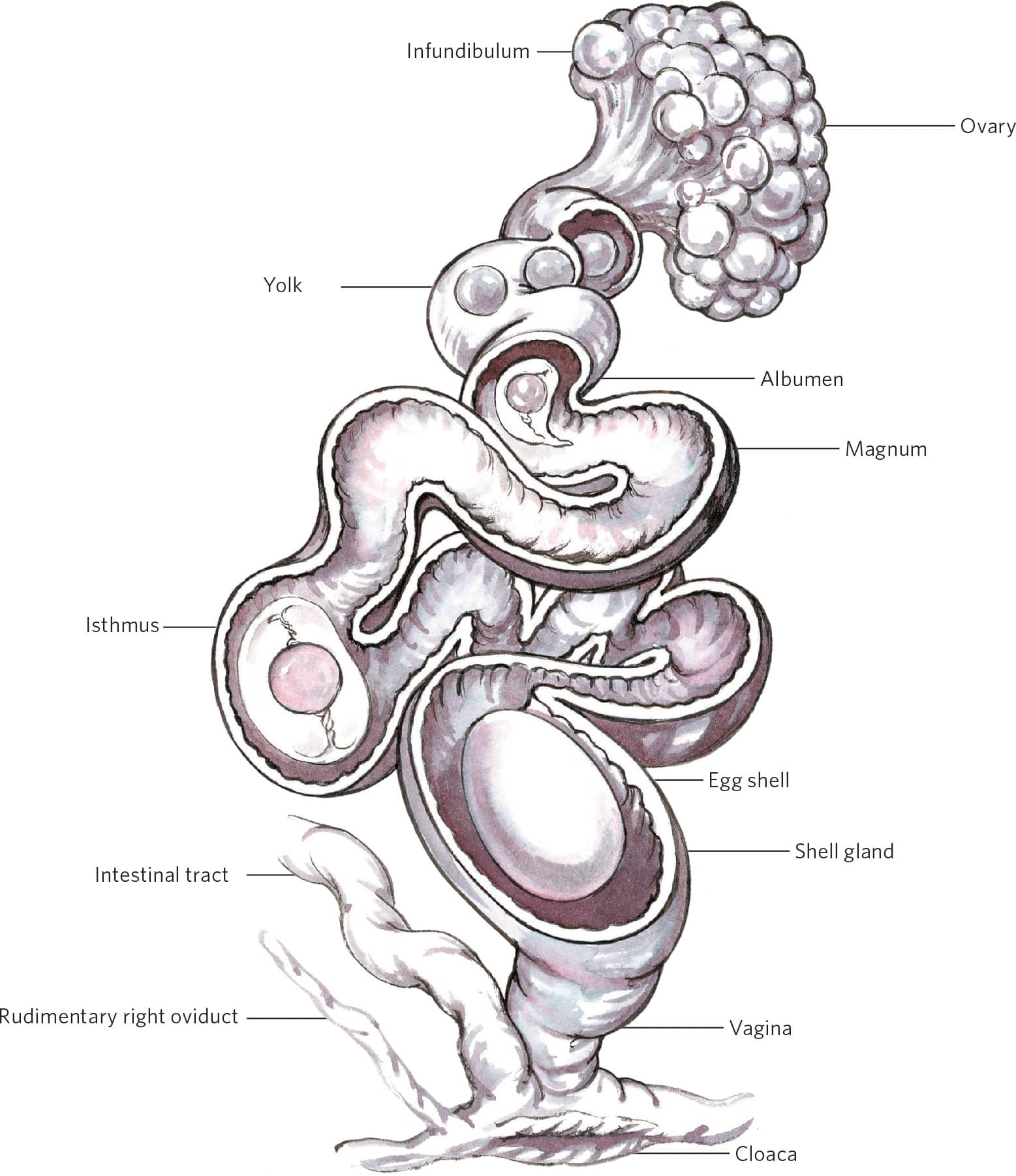
*Note: Multiple eggs are not found in the oviduct at the same time. This is a pictorial representation of the stages of egg formation.
SELECTING A BREED TO SUIT YOUR NEEDS
Which breed is right for you? Choosing your chicks may seem as simple as picking out the cutest one at the feed store, but some people want more information. The first question that always comes to minds is eggshell color. Eggs with different-colored shells do not have any nutritional difference from white-shelled eggs; the shell is the only place pigment is added. The contents are exactly the same.
The American Poultry Association puts out what’s called the American Standard of Perfection. This publication provides color, type, and size guidelines for all accepted chicken breeds and is used as a reference by many chicken owners.
Select your chicken breed based on the environment you can provide and on their behavioral tendencies. For example, if you have harsh winters and a small coop, choose a cold-hardy breed with a mellow disposition. A dual-purpose breed, one used for both meat and eggs, would be an excellent choice. We suggest breeds from the American and English classes of the American Poultry Association if you need calm, cold-hardy birds.
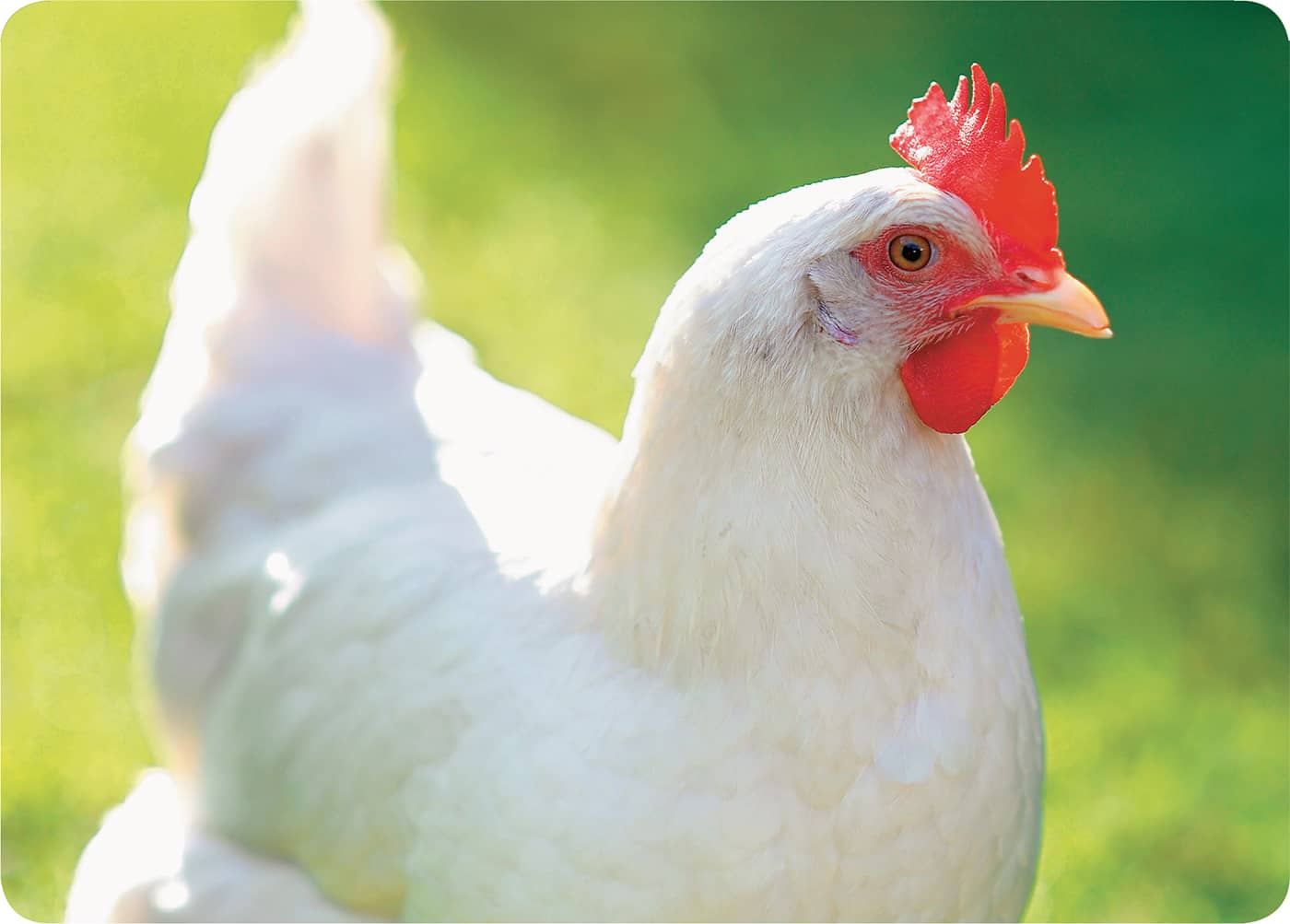
Single Comb White Leghorn
Bantams are about one-fifth the size of standard chickens. The benefits are that you can fit more of these chickens in a smaller space, and they eat much less food than their full-size counterparts. Bantam eggs are about one-third the size of standard eggs. There is one notable concern: They fly better and more readily than most larger chickens. Their wings need to be clipped or their runs need to be covered to prevent escapes.
If you instead choose a laying hen known for its high production levels such as a White Leghorn, understand that it is an extremely active breed with high levels of aggression. Alternatively, a breed selected for its rapid growth and deemed a broiler chicken (one raised for its meat) typically isn’t aggressive. Breeds developed in warmer regions of the world such as the Egyptian Fayoumi may not perform well in cold environments unless you modify the coop to meet their needs through added insulation, for example.
Although many people tend to choose chickens based on pretty feathers or eggshell color, keep in mind their behavioral needs as you make your decision. Also, make sure you take into account your city, state, and federal laws, which we discuss in chapter 3.
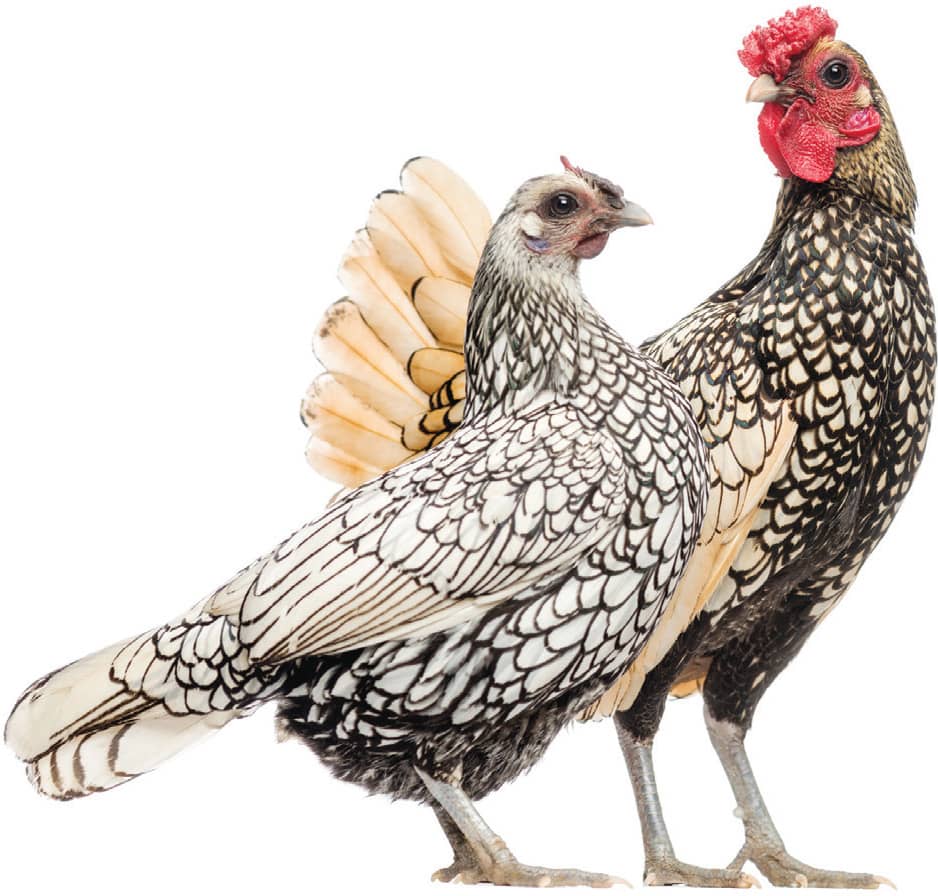
Silver Sebright male and female
Breeds with Brown-Shelled Eggs
To get you started on your backyard chicken journey, we present an introduction to each breed, along with a picture to help you decide which will enter your flock. Many breeds offer multiple varieties, so you still need to do more research to make a final decision. We suggest many of the breeds here for both their ability to lay brown eggs but also their hardiness against the cold. This list discusses large fowl only, as the color of eggshells and cold-hardiness of the bantam size for each breed can differ significantly from their large fowl counterparts.
PLYMOUTH ROCK
When people imagine an at-home flock, they typically think about the now-iconic Plymouth Rock. These are excellent dual-purpose birds in that the males are raised for meat and the hens are kept for eggs. Many people also recall hearing about Barred Rock chickens. This is a mispronunciation or abbreviation of the whole name, which is Barred Plymouth Rock.
Appearance
The hens weigh about 71/2 pounds (3.4 kg) and have yellow skin and yellow legs and toes. The breed, developed in the United States in the nineteenth century, is believed to be the result of a cross between a Dominique male and Java or Cochin female. The first variety was a Barred bird, with White sports (what some varieties are called) occasionally making an appearance. White Plymouth Rocks were the next variety accepted into the American Standard of Perfection reference. Female White Plymouth Rocks were used to create the commercial strain of meat birds raised as Cornish crosses or broiler chickens. They were key in developing broilers because they were not only good-size birds but also better egg layers than the Cornish. Other varieties of the breed still exist: Buff, Silver Penciled, Partridge, Columbian, and Blue.
Personality
The personality of this breed is best described as calm. These birds are good with children and people new to chicken-keeping. They are also sweet and genuinely want to be around their caretakers and other pets or chickens. They are curious and outgoing, the type of hens that will check out every new item you bring to the coop or backyard. They are independent, too, able to be left unsupervised and to fend for themselves quite well if left to roam in the barnyard.
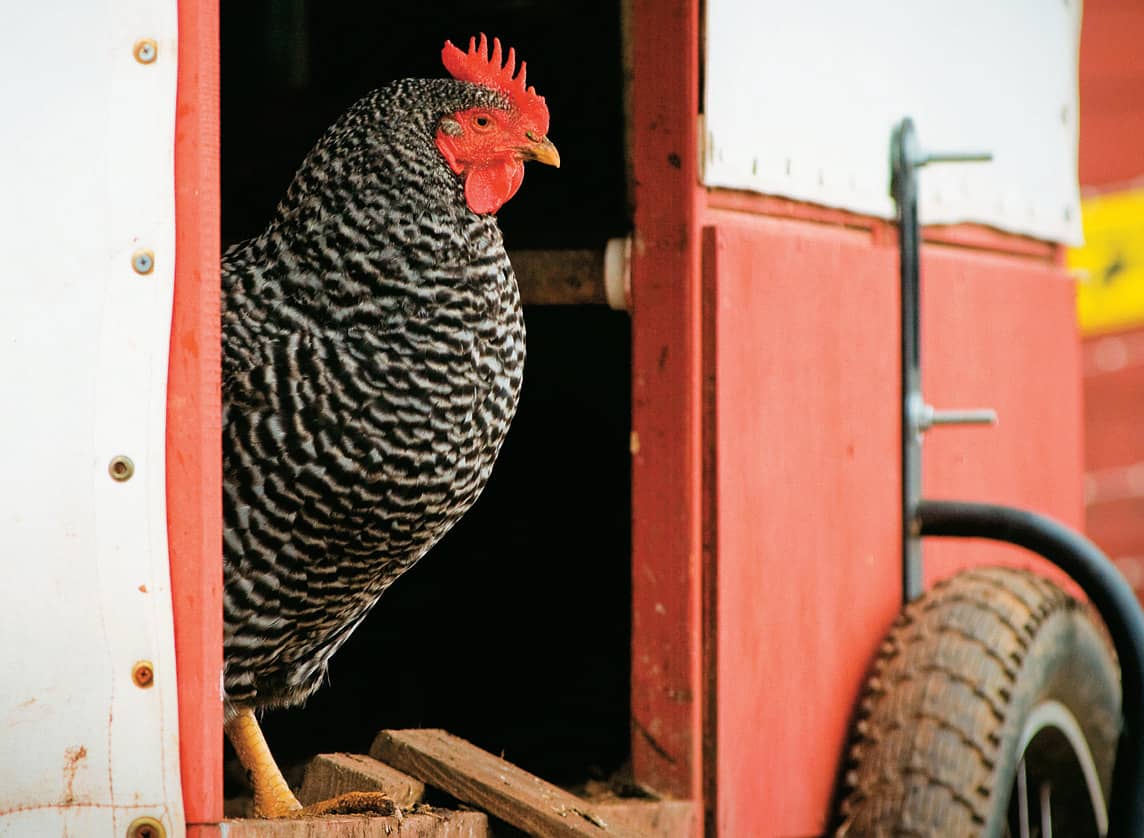
Barred Plymouth Rock
RHODE ISLAND RED
Developed in New England, in the region between Narragansett Bay, Rhode Island, and Buzzards Bay, Massachusetts, the Single Comb variety of this breed was recognized by the American Poultry Association in 1904. In 1905, the same happened with the Rose Comb variety of the Rhode Island Red. Both developed from a cross between a Red Malay Game, Leghorn, and Asiatic stock.
Appearance
Rhode Island Reds are a lustrous, deep red, almost mahogany. Even the fluff of the bird should be a rich, intense red. The tail should be black. The skin of the bird is typically yellow and the legs and toes are a rich yellow tinged with reddish horn color. The beak also is a reddish horn color. The hens weigh about 61/2 pounds (2.9 kg); pullets are about 1 pound (0.5 kg) lighter. This breed was originally used as a market bird and as such, has retained its capacity as an excellent dual-purpose breed, perhaps the best kind for egg production.
Personality
The personality of Rhode Island Reds and Rhode Island Whites (the next breed listed) are so similar that we’ll discuss both in this paragraph. They are cold-hardy hens that are as sweet as they come, curious and active birds that will readily investigate new items or till a garden at your request. They are outgoing and can get along well with well-trained family pets. They are an excellent choice for the beginning flock owner and are very good with children. As with any new chicken, taming—through regular handling from the time the birds are chicks—will need to take place to ensure a good experience for both child and chicken.
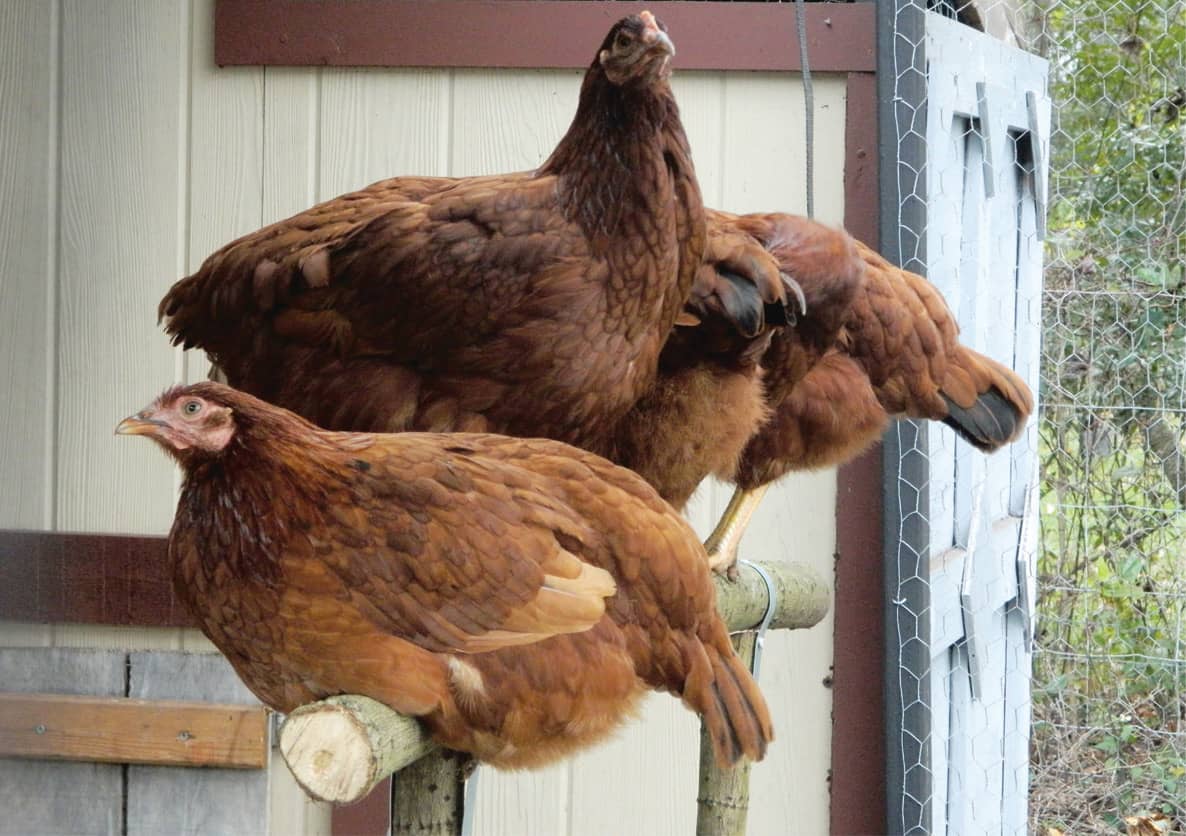
Rhode Island Red hens
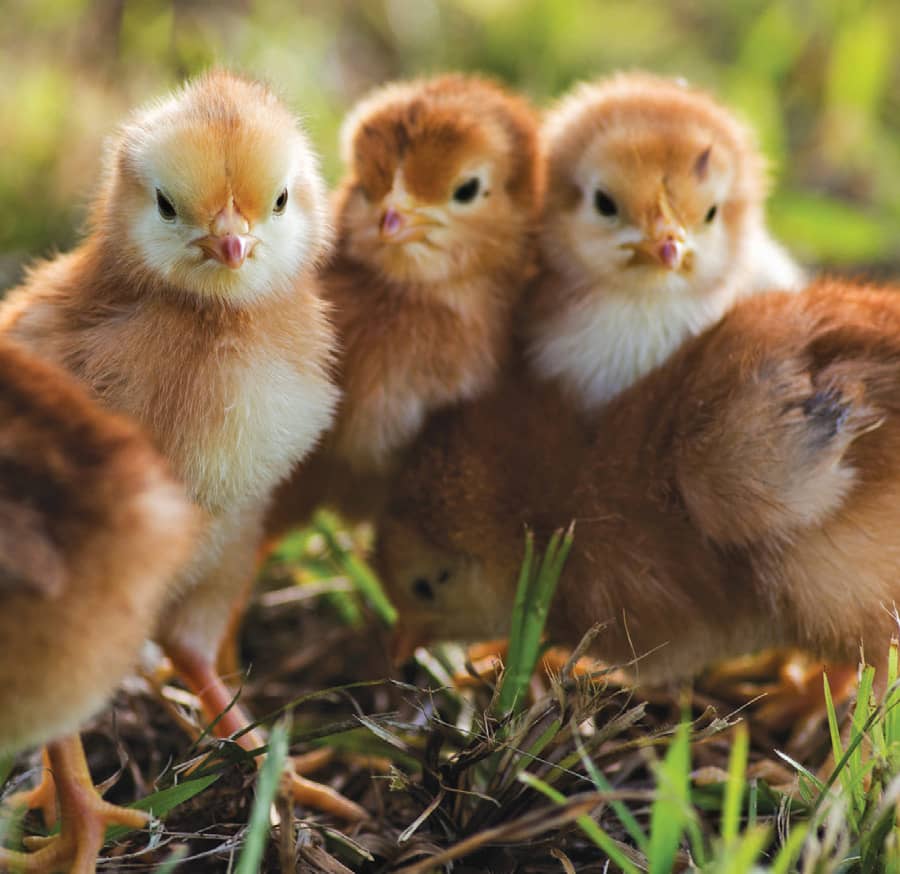
Rhode Island Red chicks
RHODE ISLAND WHITE
Many people do not realize that the Rhode Island White breed even exists. It came after its more famous counterpart, the Rhode Island Red, and it has a slightly different lineage. It was developed in Rhode Island in the late nineteenth and early twentieth centuries, the result of a cross between Partridge Cochins, White Wyandottes, and Rose Comb White Leghorns. Like Plymouth Rocks, these are dual-purpose birds, with the males used for meat and the hens for eggs. Rhode Island Whites, which are rare, come in only one variety: Rose Comb.
Appearance
The hens are about 61/2 pounds (2.9 kg), and have yellow skin and yellow legs and toes. Will this breed be the jewel in your coop?
Personality
For a description of the personality, see Rhode Island Red.
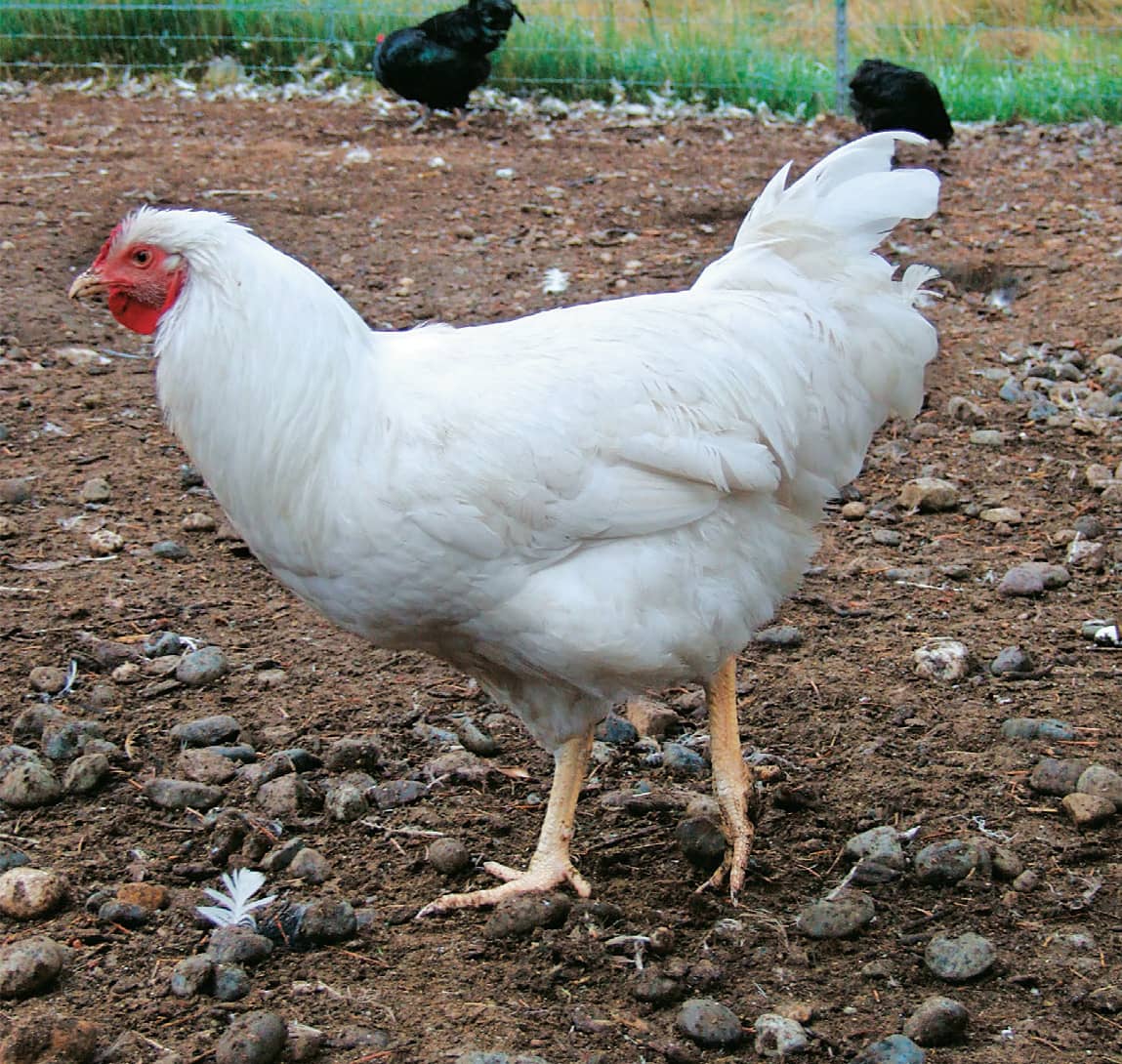
Rose Comb Rhode Island White Cockerel
BUCKEYE
The Buckeye breed has seen a resurgence in popularity over the years. It is critically endangered, but through the efforts of show poultrymen and -women, backyard flock enthusiasts, and breed preservationists, the breed is making a comeback.
Appearance
The Buckeye has the distinction of being the only breed developed by a woman, Nettie Metcalf. Named for her home state (Ohio), the Buckeye has plumage that resembles the color of the buckeye nut, similar to that of Rhode Island Reds. Its legs and toes are yellow. A cross between the Dark Cornish, Black-Breasted Red Game, Buff Cochin, and Barred Plymouth Rock, this breed is stout and wide, but not to the same degree as the Cornish. This breed comes in only one variety and has a pea comb. Hens weigh approximately 61/2 pounds (2.9 kg).
Personality
The personality of the Buckeye is not unlike the three previous breeds mentioned. These birds are sweet and depending on the strain purchased, a bit independent or standoffish. Also good with children, they are agreeable birds for poultry showmanship (the unique history of the bird offers an excellent talking point).
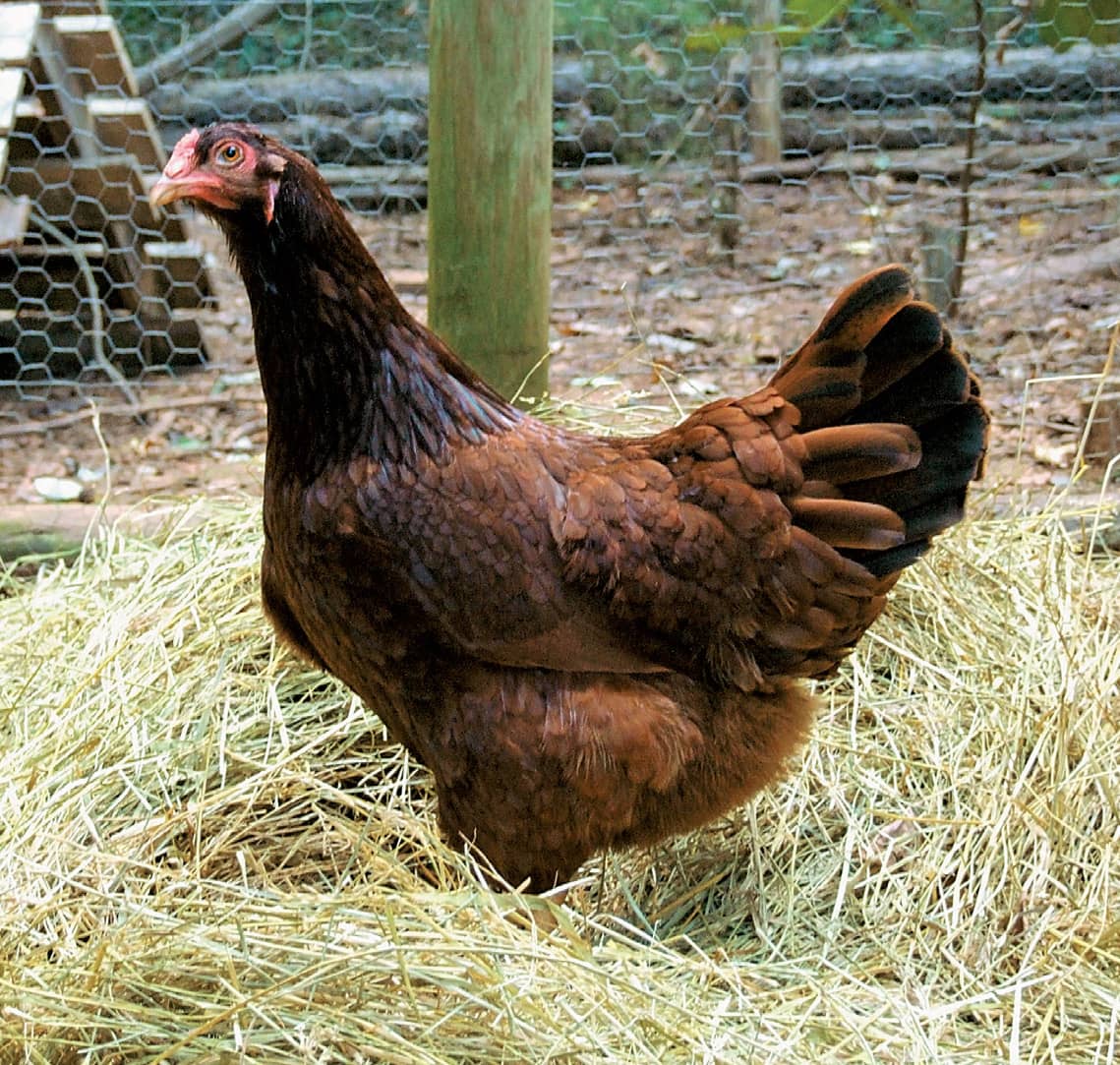
Buckeye
NEW HAMPSHIRE
Nowadays, we think of New Hampshire as an egg-laying breed, but its history and selection lean it more toward a meat bird. Therefore, it is truly dual-purpose breed. The lineage stems entirely from the Rhode Island Red. It moved from the Rhode Island area up into the New Hampshire region, where it was selected for rapid growth, fast feathering (handy in the cold northern parts), early maturity, and vigor. Eventually an entirely new breed developed from the farm stock maintained by New Hampshire’s farmers.
Appearance
These birds are brown egg layers, and they also produce a good-sized carcass. The color of the pinfeathers do not detract, as they are a reddish buff color. They are fair, but not the highest producing, egg layers.
Personality
New Hampshires can be aggressive, competitive, and dominant within the flock. They are curious birds and quite independent. They also are likely to wander off and lay eggs in a private clutch rather than the nest boxes you kindly provided (although this can be said about other breeds as well).
CHANTECLER
The Chantecler, the only breed from Canada, was bred specifically to handle the region’s cold winter conditions. The goal was to develop birds with a small comb and wattles that laid well through the winter months and had good health and vigor. Bred by monks, lead by Br. Wilfred Chatelain from 1908 to 1918 at the Oka Agricultural Institute in Quebec, the breed came from two separate crosses.
Specific lineages for hens and roosters were created, then mated together, with subsequent selections done to create the bird that we know today.
Appearance
The Chantecler is one of the only chickens with a cushion comb. The hens are 61/2 pounds (2.9 kg) and the breed comes in two varieties: White and Partridge. Yellow skin, legs, toes, and beak round out the White variety. The Partridge variety has a dark horn beak that shades to yellow at the point.
Personality
A Chantecler is a classic, cordial, but independent farmyard chicken. The hens lay a fair number of eggs and are often a favorite of small flock owners due to their sweet nature.
DOMINIQUE
This breed has the distinction of being the United States’ oldest. As such, its lineage is a bit hazy. These birds are dual-purpose and come in only one variety, Barred.
Appearance
To the untrained eye, this breed looks similar to a Barred Plymouth Rock; the key is in the comb. The Dominique has a rose comb while the Barred Plymouth Rock has a single comb. The Dominique also carries its tail at or higher than a forty-five degree angle above horizontal while the Plymouth Rock carries its tail at thirty degrees. The beak, toes, and legs of the Dominique are all yellow. The breed in general is a bit smaller, with hens weighing in at 5 pounds (2.3 kg). The hens are fair layers of brown-shelled eggs.
Personality
Dominique hens are sweet and curious. Like Plymouth Rocks, they like to spend time with flock mates and human caretakers alike. They will check out every new item you bring to the coop or the backyard. They are sweet with children and are often the bird of choice for the youngest flock owners in your family because the hens are lighter. These easy-to-pick-up hens do not fuss much and get along well with other pets and livestock. But there is a note of caution: Given their slightly smaller size and docile nature, these birds can be pushed around a little at feeding time by other, larger flock members.

Dominique hen
WYANDOTTE
If ever a bird or breed got ooohhhs or aaaahhhs from novice poultry enthusiasts, it is the Wyandotte. This beautiful breed was developed in New York State. The original variety, Silver Laced, is considered the parent of the Wyandotte family. It is sometimes called an American Sebright or Sebright Cochin. Although the exact breeds used to create the Wyandotte remain unknown, it is suspected these include the Dark Brahma and Silver Spangled Hamburg. This is also evidenced by the fact that Wyandottes have rose combs.
The Golden Laced variety came next among the Wyandottes, from a mating between a Silver Laced Wyandotte female and a crossbred Partridge Cochin/Brown Leghorn cockerel. Both the White and Black varieties came from sports of the Silver Laced variety. The Buff variety descended from Rhode Island Reds of poor type and color. Thus these birds were crossed with other breeds and the Wyandotte to create the Buff variety. The Partridge variety consisted of two independent efforts in its creation. The last Wyandotte variety is the Columbian. Often overlooked, yet an elegant and stunning variety, the Columbian was named after the Columbian Exposition of the World’s Fair held in Chicago, where it made its exhibition debut.
Appearance
This breed is often recognized as the jewel of the chicken coop, though it is quite often overlooked due to the popularity of other more common and well-known breeds. It is the discerning flock owner who chooses the Wyandotte. This fairly good egg layer is an average-size bird weighing in at about 61/2 pounds (2.9 kg). The rose combs are small and are not prone to freezing. Although not to be kept as breeders, an occasional single comb sport can be seen in offspring.
Personality
The hens are sweet, curious, good mothers, and well behaved with children. They walk with you and cluck or talk with great frequency. Thus, many owners view them as understanding a conversation. The beauty and good disposition of this variety usually garners the most interest and comments from anyone visiting your flock.
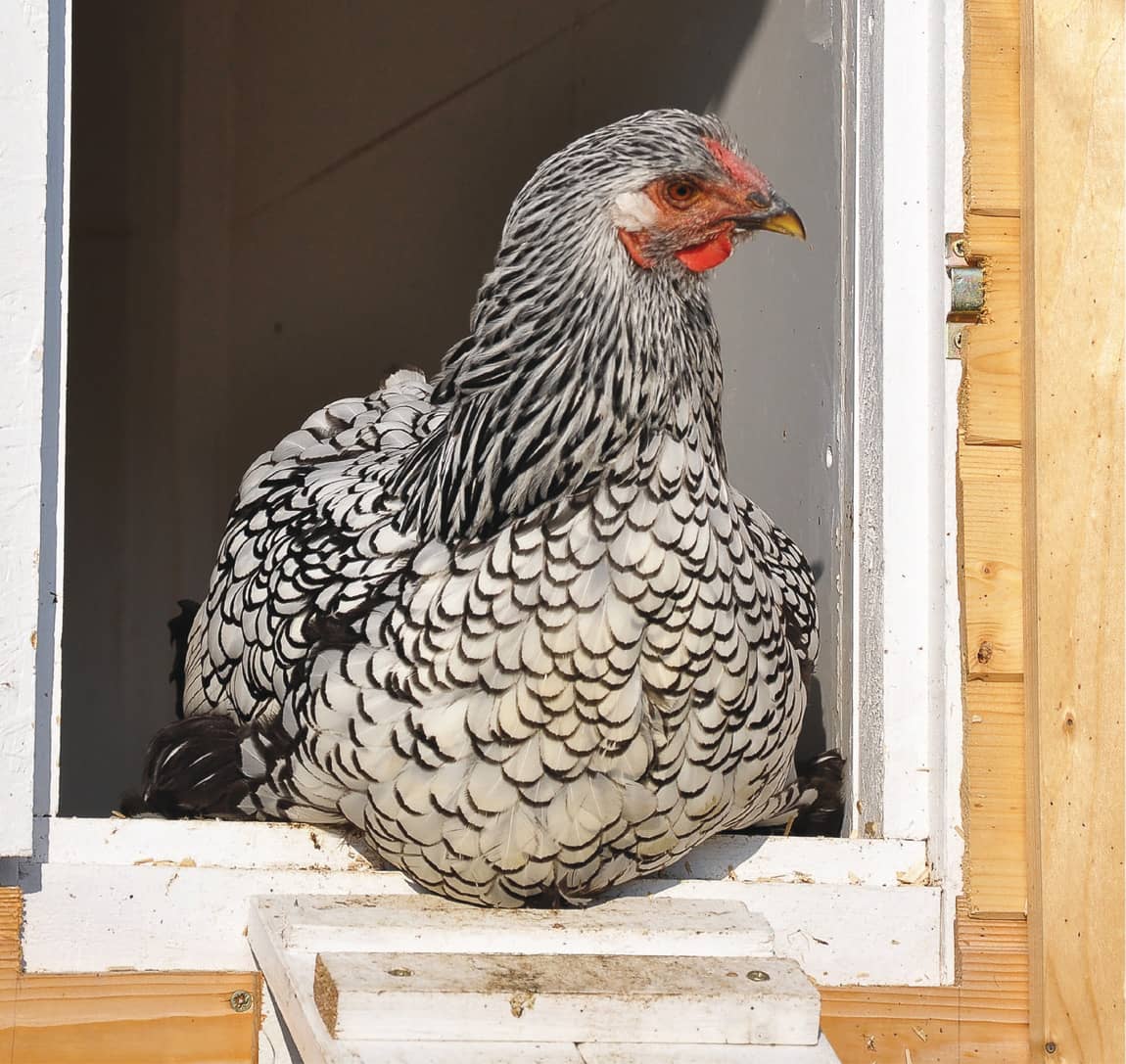
Silver Laced Wyandotte
DELAWARE
Don’t confuse the Delaware breed with the Delaware Blue hen. The two breeds, although both exceedingly rare, differ vastly in personality and function. Blue hens descend from fighting stock, are very athletic, and are not recommended for a beginning flock owner. Delawares, on the other hand, were the first attempt at creating a broiler or meat chicken.
Appearance
The cross between Barred Plymouth Rock males and New Hampshire females yielded oddly colored sports. The most striking feature of the Delaware is the barred hackle and tail feathers, while the rest of the bird is pure white. The hens weigh approximately 61/2 pounds (2.9 kg) and are good layers. The males make fine broiler chickens. Another unique feature is that backcrossing of the Delaware to other breeds yields sex-linked chicks. For example, Delaware males bred to Rhode Island Red or New Hampshire females yield chicks with the markings and plumage of the Delaware. But Delaware hens bred to male Rhode Island Reds or New Hampshires yield the sex-linked chicks. Male chicks will have the Delaware pattern and female chicks will have the solid red feather pattern and therefore can be identified at hatch.
Personality
The Delaware yields even-tempered hens that are independent birds designed for foraging in the barnyard. These hens are easily tamed and therefore become good companions for the gardener. They have bright, inquisitive eyes and are often a quiet breed. Not always willing to share what’s on their mind, they instead tend to quietly follow caretakers around the yard while tilling and turning the soil. A Delaware will still alert you to problems such as predators. They are very good mothers and good with children.
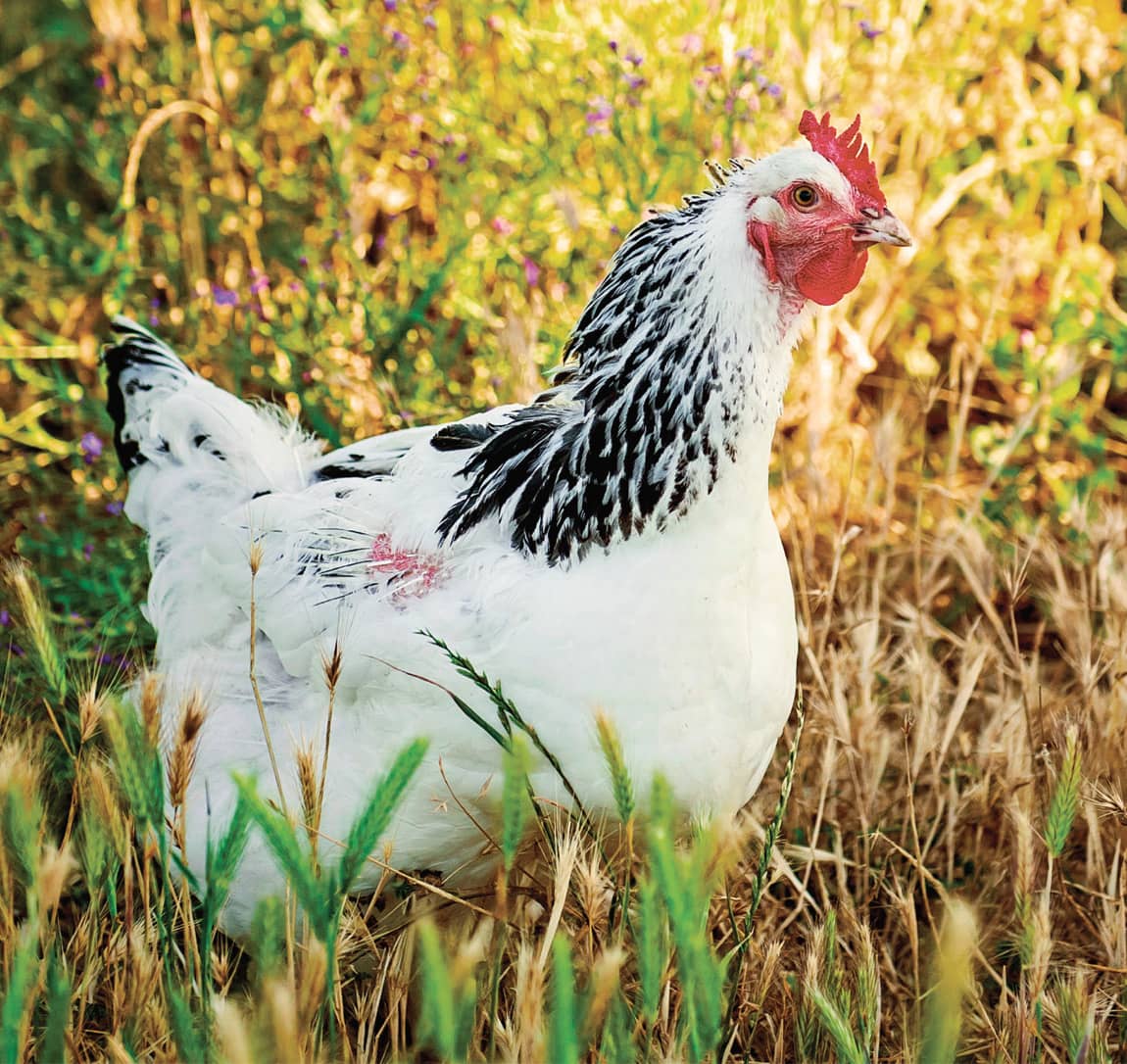
Delaware
ORPINGTON
Orpington is a large breed that hails from the town of Orpington in County Kent, England, so it falls into the English class. It is derived from a cross between a Black Langshan, Black Minorca, and Black Plymouth Rock. The popularity of these birds in the United States was solidified when they were shown in great numbers at the 1895 Madison Square Garden Show in New York. Their size makes them excellent as dual-purpose birds as both the hens and roosters can be used for meat.
Appearance
These birds carry many feathers held loosely from the body, making them appear even larger than they already are (hens weigh 8 pounds [3.6 kg]). These soft feathers are often solid in color as the hens come in White, Black, Blue, and Buff. (The Buff variety is the most popular, although White comes in a close second.)
Personality
Orpingtons are sweethearts. They walk with you and talk with you about absolutely everything. They have reddish bay eyes that beckon for conversation and watch your every move. They are docile and excellent with children, although quite sizable and difficult for children to carry. They are not aggressive and are excellent mothers. They do, however, tend to go broody (see chapter 5 for more on hens going broody) and are good incubators. Despite their size and given their sweet nature, these birds can be the lowest in the peck order, so be sure to select even-tempered breeds to raise with them. Or raise a flock entirely composed of Orpingtons.
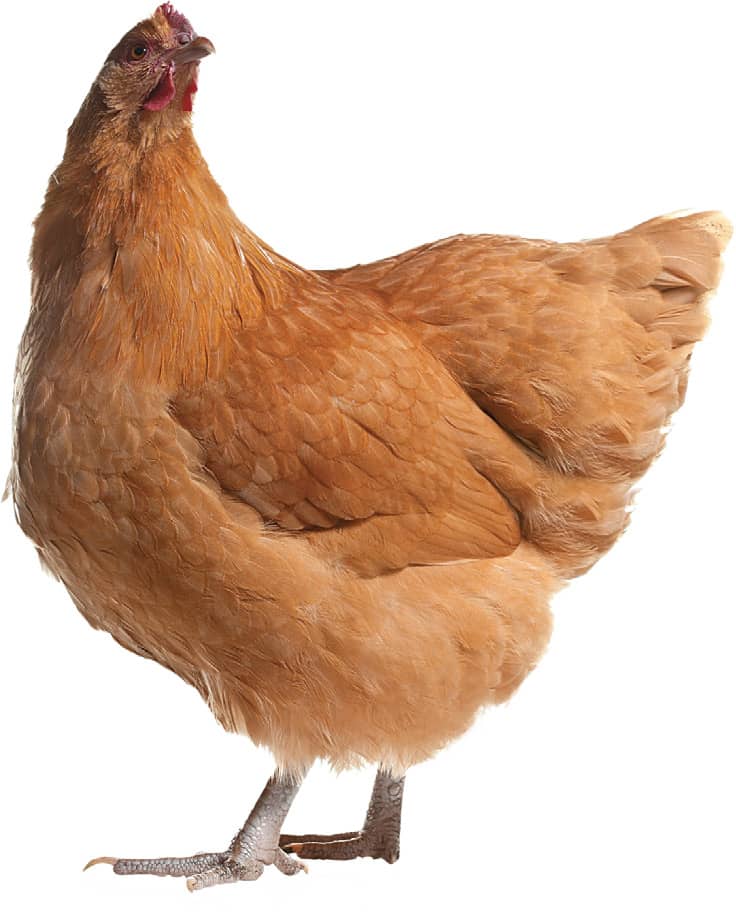
Buff Orpington hen
AUSTRALORP
The Australorp is a breed of chicken that lays large numbers of brown-shelled eggs. It is also the only breed from Australia and is in the English class, dating back to the days of the British colonies. The breed was developed out of Black Orpington stock and was known as a production-bred Australian Black Orpington.
Appearance
They only come in black, but they should have a lustrous green sheen to their feathers. The hens weigh 61/2 pounds (2.9 kg). They are great egg layers. In fact, in one Australian test, a hen was recorded to have laid 364 eggs in 365 days!
Personality
The breed is sweet, curious, social, and a good forager. These birds do not tend to go broody and make an excellent selection for the farmer wishing to start a small enterprise with brown-shelled egg layers. They also have dark-colored eyes that appear quite inquisitive.

Australorp hen
SUSSEX
The Sussex breed hails from Sussex County in England and is cold-hardy. It is an old breed, typically kept as dual-purpose. Sussex County was known for producing high-quality table fowl. With the production of a fowl for meat also came the demand for that bird, hence the breed also has good egg-laying characteristics.
Appearance
The feature of this breed that interests most flock owners is its plumage. The Speckled Sussex has mostly reddish feathers, each tipped at the end with a white spangle. Between the reddish bay on each feather and the spangle lies a black bar. This interesting feather pattern has increased the Speckled Sussex’s popularity among small flock owners. Do not forget about the other two varieties in which this breed comes. Red Sussex are a deep mahogany color, with pinkish-white legs and toes. The Light Sussex has a color pattern that mimics the Columbian Plymouth Rock.
Personality
Soft-spoken, yet independent and inquisitive, the Sussex is an excellent choice for small flocks. These birds are good with children. Plus, they are active and will make a beautiful addition to your backyard flock. They are good setters and willingly sit on eggs and brood chicks.
High Energy, White-Shelled Egg Layers
Many white-shelled egg layers also tend to be breeds that hail from the world’s warmer regions. Some of the breeds mentioned in this chapter are also high-energy birds. This means they aren’t necessarily as friendly and may have a tendency toward flightiness. Of course, this does not apply to every bird in every case.
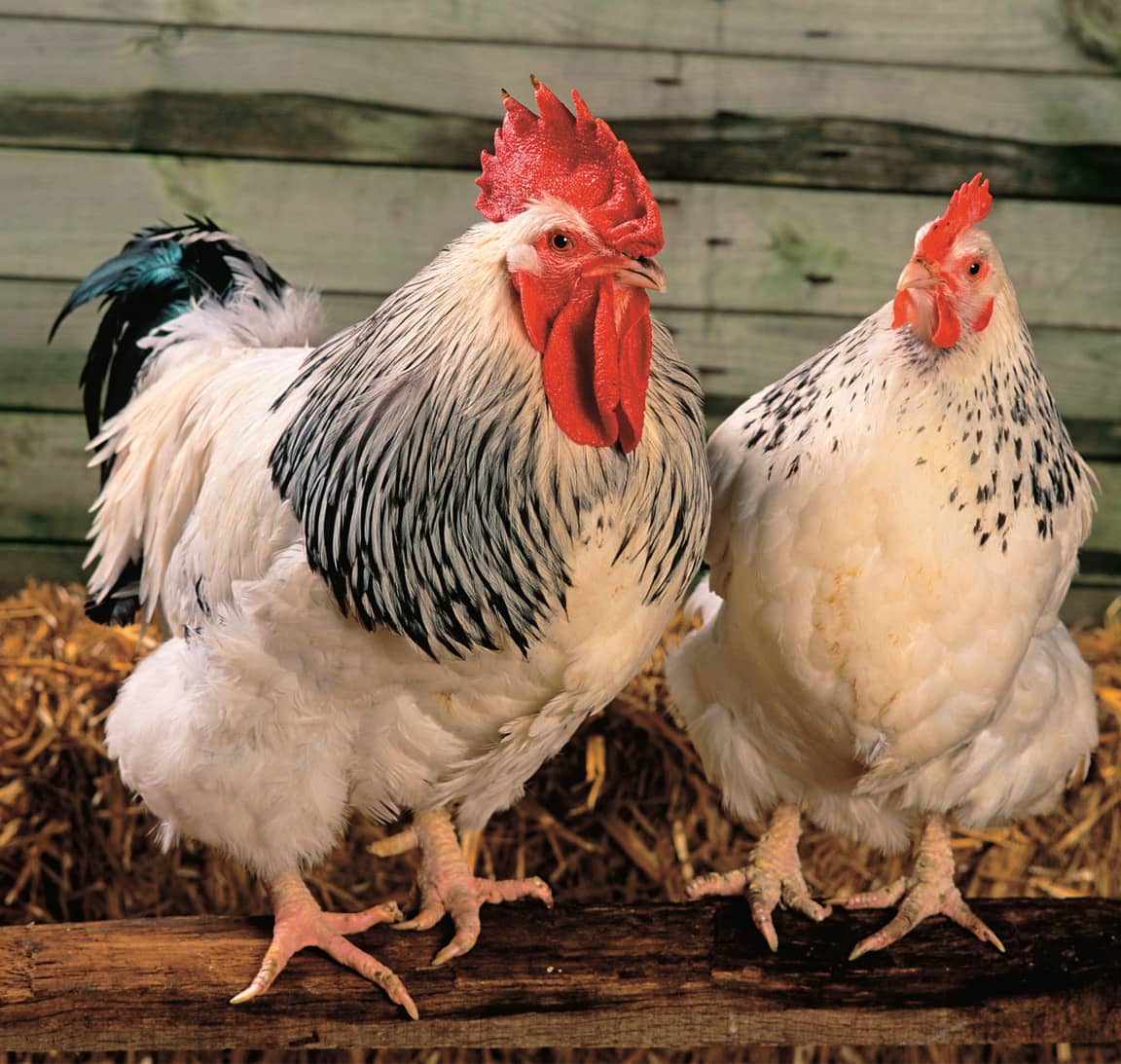
Sussex
LEGHORN
The Leghorn is known for its high egg production. In fact, it is considered the best egg-laying breed and the stick by which all others are measured. Though the Single Comb White Leghorn, (see here), is the foundation breed for the modern commercial egg-laying industry, Leghorns do come in many beautiful varieties. The breed originates from the Livorno region of Italy and is therefore part of the Mediterranean class. These are hardy birds, but not necessarily cold-hardy. They eat one-third less than their brown-egg laying counterparts, yet lay more eggs, making them a logical economic choice for small businesses in need of white-shelled eggs.
Appearance
Leghorn hens have large combs that flop over one side of their heads, either partially or fully obscuring one eye. There are at least ten Single Comb varieties, including Light Brown, Dark Brown, Buff, Red, Columbian, and Golden Duckwing, to name a few. There are fewer Rose Comb varieties, but they include Light Brown, Dark Brown, White, Buff, and Silver. These birds are small-bodied with large combs, making winter care more of an effort for their caretakers. Leghorns, as a breed, are known for a distinct lack of broodiness.
Personality
Leghorns are flighty and noisy. Many first-time flock owners who start with Leghorns coupled with brown-shelled egg layers prefer the calmer tendencies of the latter birds. Easily frightened, the high-strung Leghorns are watchful and prefer to keep their distance from new items and people. They are strong fliers given their light body frame and small weight of 41/2 pounds (2 kg). They are aggressive if overcrowded and tend to become the dominant members of a mixed flock. Given the right conditions, Leghorns are good layers but are not a preferred first choice for small or backyard flock owners. Reserve the Leghorn for your second or third flock—when you may want more of a challenge.
ANCONA
For several decades, the Ancona was considered just another variety of Leghorn. Just like the Leghorn, this breed also comes in Single and Rose Comb varieties. Descended from hens of central Italy, the breed was named for the port from which it was sent to Great Britain. It is in the Mediterranean class of chickens and is not cold-hardy.
Appearance
These hens weigh 41/2 pounds (2 kg) and are known for their lack of broodiness. Though there is only one Ancona color variety—Mottled—the breed is gaining popularity because of its unique look. Each feather is black with white tips. Like Leghorns, these birds also have a large comb that flops to one side of the head. At one time the breed was known for its excellent egg production, but now these birds are strictly ornamental.
Personality
The Ancona, quite a flighty breed, can get as noisy as the Leghorn. The hens are not good choices for backyard flock owners. They are not good with children although they are great yard or garden foragers. These birds are strong fliers, so clip one wing on each bird to prevent roosting in trees.
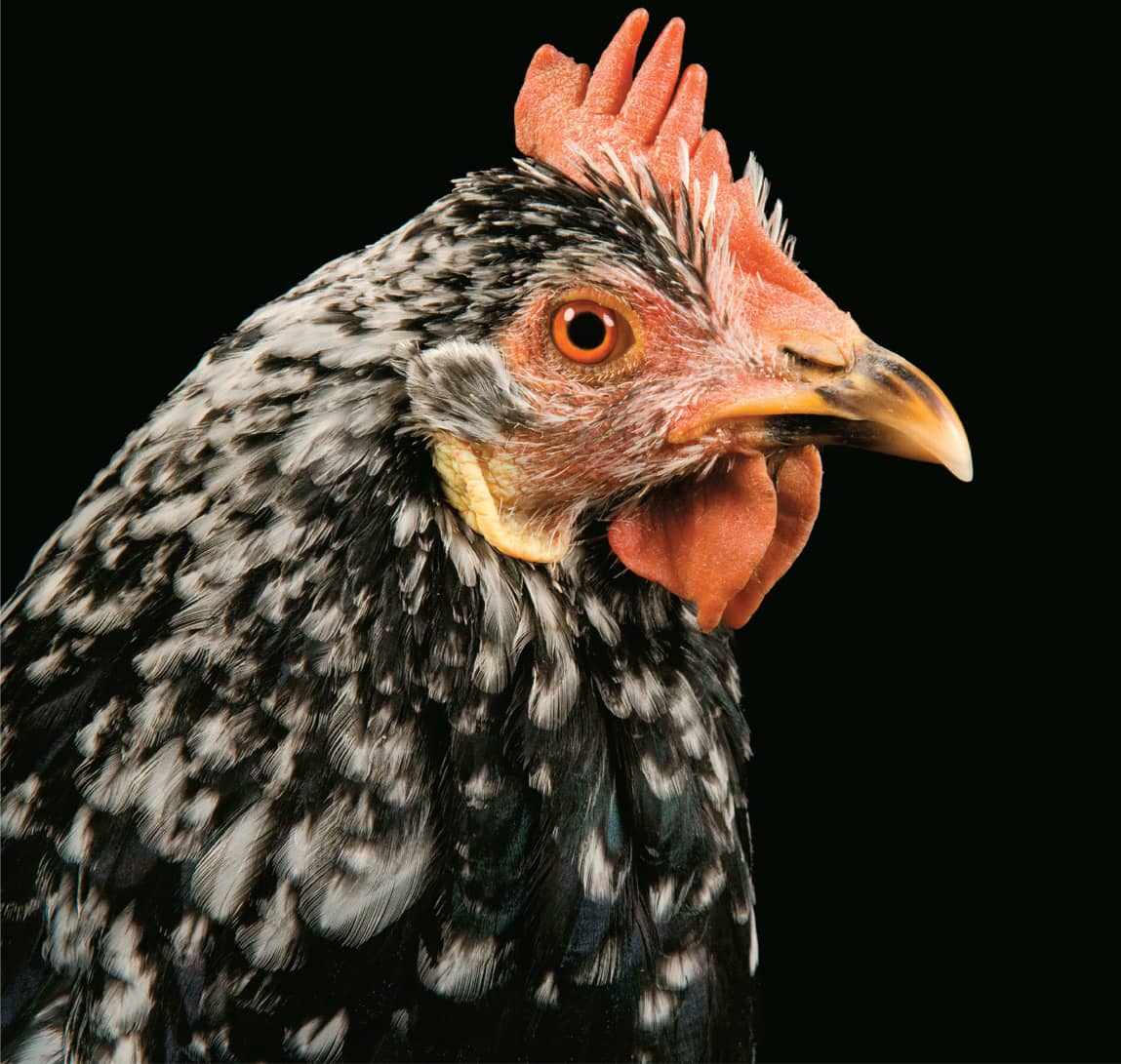
Ancona
ANDALUSIAN
As its name implies, this breed hails from Spain’s Andalusian region. As such, it belongs in the Mediterranean class and comes in a most beautiful variety: Blue.
Appearance
Blue Andalusians are blue slate or slate gray. The Blue Andalusian is a perfect example of color genetics in poultry. The original bird—as is occasionally done with today’s birds—was bred from a cross between a Black bird and its White sport offspring. A result of incomplete dominance, the blue color is unusual and difficult to maintain. These birds are slightly larger than Leghorns, weighing in at 51/2 pounds (2.5 kg).
Personality
These light-bodied, high-energy birds are excellent foragers. They are elegant and inquisitive yet initially standoffish. Once they get to know their handlers, they like spending time with them in the garden and are extremely alert to changes, new people, or predators. They also can be aggressive toward other hens and tend not to go broody. A decent choice for small flock owners who want white-shelled eggs, these birds are intelligent and relatively easy to tame.

Blue Andalusian hen
HAMBURG
Many think the Hamburg breed comes from Germany, as the name would imply, but actually, the Hamburg originated in Holland. Breeders in Germany and Great Britain, however, refined the breed to what it is today: Pheasantlike in body shape and behavior. The breed is known as a good layer—giving it the unique nickname of “The Dutch Everyday Layer”—but laying medium-size eggs.
Appearance
Hamburgs have beautiful plumage and come in six varieties: Golden Spangled, Golden Penciled, Silver Spangled, Silver Penciled, White, and Black.
Personality
This is a high-strung breed with a rather wild and flighty temperament. It is not recommended for first-time flock owners. These birds are noisy and excellent fliers, so prevent tree roosting and escape by clipping one wing. They are excellent at foraging on their own and are independent, preferring to spend almost no time with humans.

Hamburg
DORKING
Originating in Italy, this ancient breed came with the Romans to Great Britain, where most of its development took place. This breed is in the English class and is somewhat cold-hardy. These birds do have larger combs and therefore require a bit more protection from frostbite, but this dual-purpose breed is better known for its other unique features.
Appearance
The body is squat and square, with Silver-Gray hens having a beautifully varied plumage. (This breed also comes in the White variety.) These birds have five toes and the hens weigh about 7 pounds (3 kg). It’s one of the few breeds whose birds have red earlobes but actually lay white-shelled eggs.
Personality
The breed is docile in temperament and the hens are good foragers and tend to go broody, making them good for sitting on eggs. Keep this detail in mind if you intend to keep the breed for egg laying. Hens that go broody do not lay eggs. This is a sweet breed that spends plenty of time with you in the yard yet is independent enough that the birds can be left to work on their own in the garden.
Other Eggshell Colors and Accoutrements
Although we’ve mentioned many chicken breeds thus far, there are still many more out there with unique or intriguing features. For example, many breeds become famous for unusual feather accoutrements or eggshell colors. If you wish to sell your extra dozens, pay special attention to the breeds in this section. They will certainly put your flock on the map!
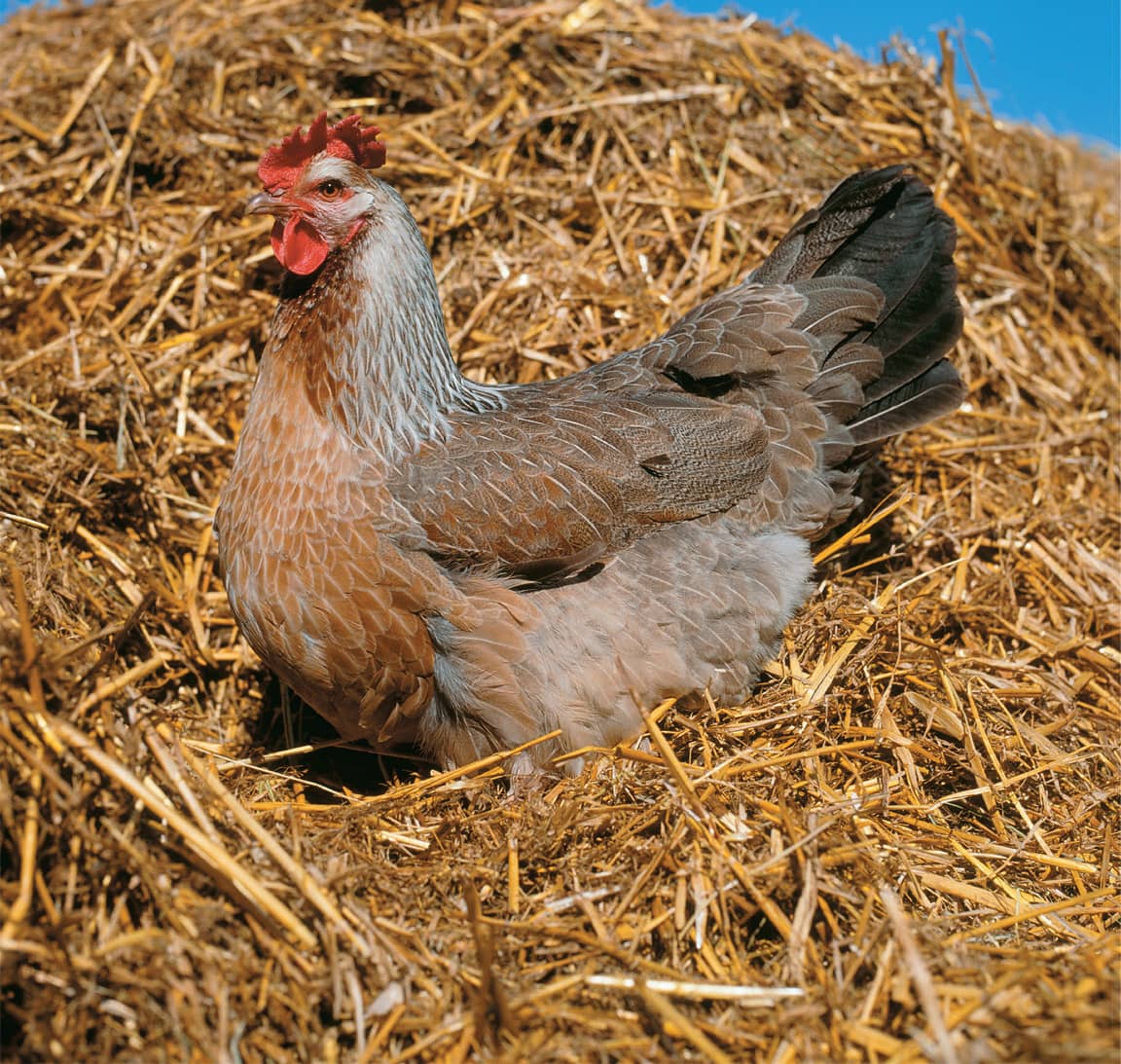
Dorking
AMERAUCANA
This breed, a derivative of the Araucana, produces blue-green or turquoise shelled eggs. The Ameraucana came about to create a dual-purpose breed that not only had the unique eggshell color but also good meat production qualities. The Ameraucana is more easily obtained than the Araucana and therefore costs less. Note the correct name spelling here. Many hatcheries and feed stores tend to misspell the name as “Americana.” Often Ameraucana crosses are sold as Easter eggers or olive eggers, but be aware that the blue-green eggshell colors may be sacrificed in favor of body type and increased egg production.
Appearance
The Ameraucana does not have ear tufts. Instead, the breed has a beard and muffs under the beak in place of wattles. Through crossbreeding the Araucana with other breeds, a tail also emerged in this breed.
Personality
Many flock owners find this sweet, curious breed quite enjoyable in the yard. Much like the Plymouth Rock, these hens show you how much fun your own backyard can be! They are excellent with children but grow larger than their progenitors, weighing in at 51/2 pounds (2.5 kg). They are good layers and can make good mothers.
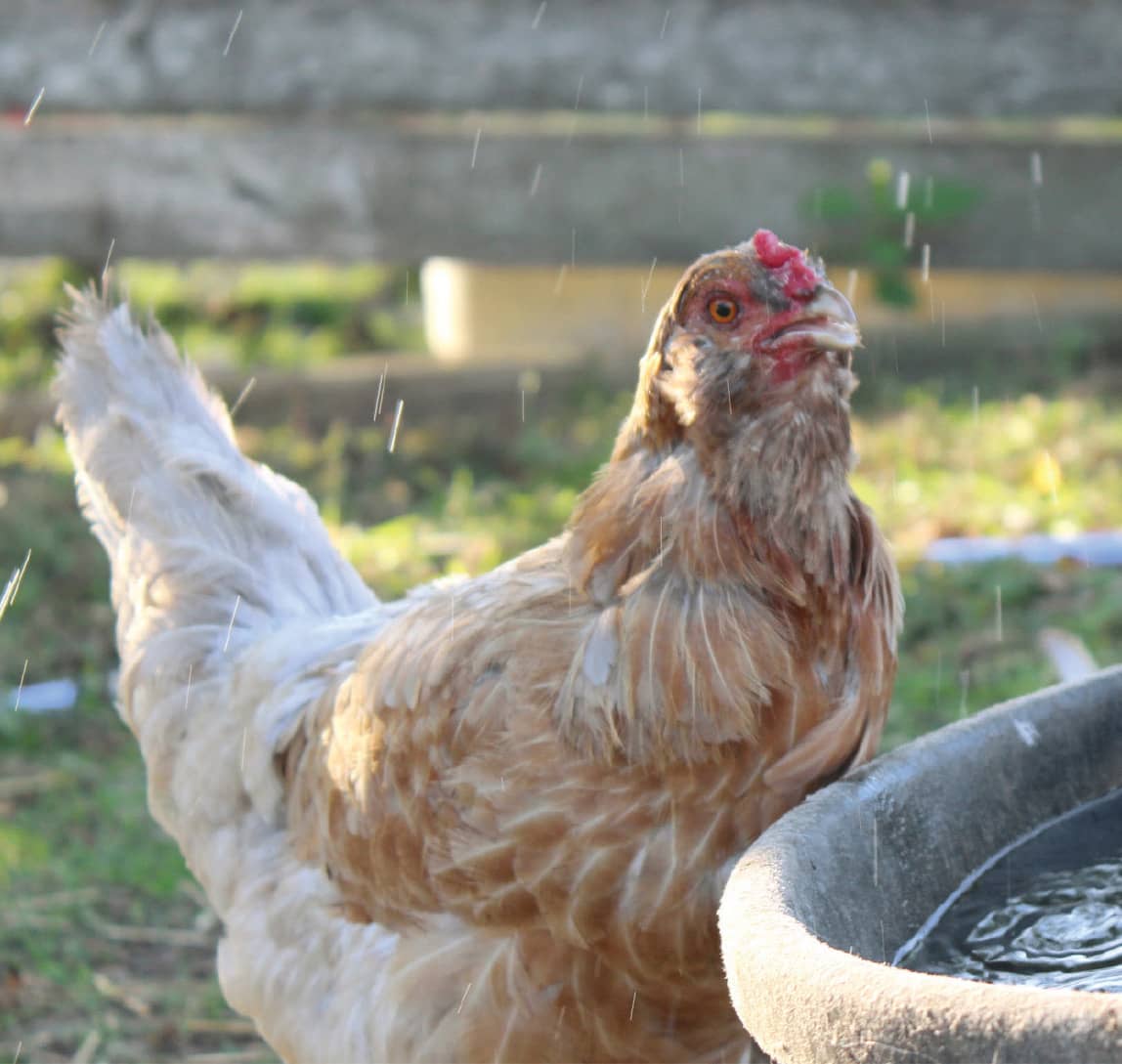
Ameraucana
ARAUCANA
This is the breed that lays the famous turquoise eggshell. Unfortunately, more often than not, the Araucana gets confused with the Ameraucana. The distinction must be understood as the two are very different. One gave rise to the other! The Araucana is the only breed to hail from South America, specifically Araucana, Chile. Little is known about its history, but it is a good dual-purpose breed. The blue-green eggshell trait is dominant and will persist in the next generation even if crossed with another breed.
Appearance
The original breed should be rumpless, or without a tail. This happens because these birds are missing the last segment of their spine where tail feathers typically sit. Another unique feature of the Araucana is that it has an extra bone in each ear, upon which grow feather tufts. An Araucana should have wattles beneath its beak, too. If you purchase what you thought were Araucanas and the birds grow tails, you likely got Ameraucanas instead. Buyer beware: You did not get pure stock! True Araucanas come in Black, Black Red, Golden Duckwing, Silver Duckwing, and White varieties.
Personality
Araucana hens are sweet, curious, and active foragers. They are definitely worth the investment, but insist on quality stock. They are excellent birds for children as they are light hens (only 4 pounds [1.8 kg]) and provide excellent talking points for showmanship.
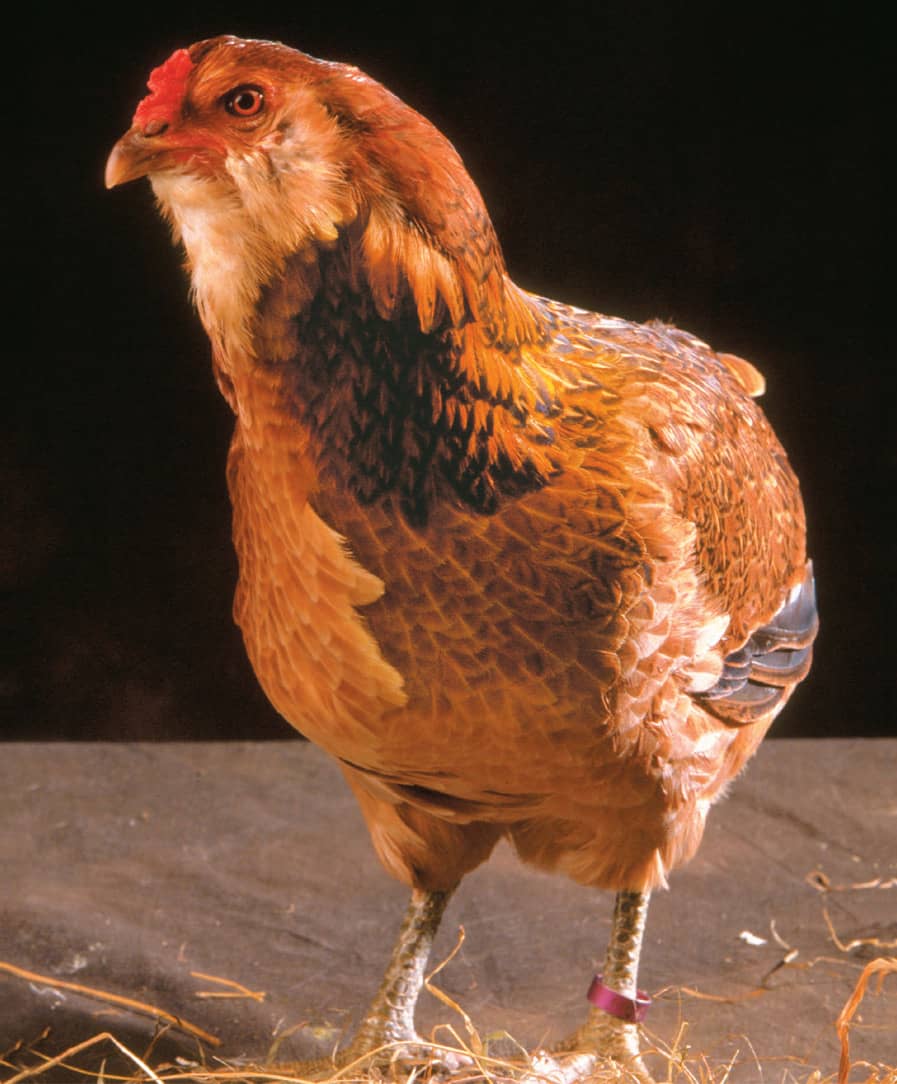
Araucana
COCHIN
The Cochin is a very old chicken breed that came from China. It falls into the Asiatic class. The breed arrived in Great Britain and America in 1845, where the birds caused a Cochin craze: Everybody wanted them, everyone bred them. Today’s Cochins are mainly used for ornamental purposes and will certainly be a keen talking point if added to your flock. They are not fast-moving hens, but they will forage with other chickens in the yard.
Appearance
These birds have feathered feet and shanks, making them prone to muddy, dirty feathers after it rains; keep them in confinement on wet days. They are loose-feathered birds that look like large, round puffballs with so many feathers that no light can pass between the legs. These birds come in Buff, White, Black, and Partridge, with high-quality Partridge being the most difficult to find and Buff remaining the most popular. The Cochin is cold-hardy, although it has a large comb, meaning take extra care on cold days. These large hens weigh about 81/2 pounds (3.9 kg).
Personality
Cochins are known for their extraordinary mothering characteristics. They are prone to broodiness and though they are not profuse egg layers, they again and again raise broods of chicks to adulthood. Be aware though that you’ll need to force some of these hens off the nest to encourage eating and drinking. Also, they are sweet and curious birds. Despite their large size, they are heartily recommended for children. The hens are patient, kind, and talk to their caretakers; like the Orpington, this breed is a thoughtful clucker and all you need do is respond—you may even see a little smile form on their beaks!

Cochin
FAVEROLLES
The Faverolles breed comes from the village by the same name in France, and it is in the Continental class. It is a result of many years of breeding between the Houdan, Dorking, and several Asiatic breeds. These birds were bred for winter egg production and are cold-hardy.
Appearance
Because the breed has fairly loose feathering, these birds appear larger than they actually are. The hens weigh about 61/2 pounds (2.9 kg) and have a beard and muffs beneath the beak. Members of this breed have a fifth toe along with feathered shanks and a small single comb. They lay lightly tinted brown- to tan-shelled eggs. Chiefly used for ornamental purposes, this breed has beautiful plumage. The Salmon Faverolles, for example, has beautiful pastel plumage that makes it a popular selection. The breed also comes in White.
Personality
Though quiet and sweet birds when it comes to being around children, these hens are gregarious and curious about their surroundings. They also are excellent showmanship birds. They always appear alert as their tails rest at fifty degrees above horizontal. This is a good breed for a beginning flock owner, but do not expect high levels of egg production.

Faverolles
BRAHMA
Brahma, developed in China, was originally called Chittagong, Gray Shanghai, and Brahma Pootra. The name was later shortened to the Brahma. It is considered a cross between the Malay and Cochin in India.
Appearance
The first varieties of Brahma were Light and Dark, followed fifty years later by the Buff. These birds should not have feathering as loose as the Cochin but should have feathered shanks and feet. They also need especially deep bedding to preserve the feathers on their feet (not unlike the Cochin, which should be kept out of the mud as well). The hens weigh 91/2 pounds (4.3 kg), have a pea comb, and are decent egg layers. Their deep-set eyes makes them appear stern, but do not let that small detail deter you from adding this stately bird to your flock. They make good mothers but are mainly kept for ornamental purposes.
Personality
They are well known for their size and height, yet gentle in nature. Even Brahma males are docile enough for children to handle (though the roosters can weigh about 12 pounds [5.4 kg], so it is not recommended). Patient with children, Brahma make excellent showmanship birds. They are not the fastest moving flock members and prefer to mosey around the garden instead. They are quiet except when purposely directing clucking comments at their caretakers. These soft-spoken birds are sure to be the biggest in your coop.

Light Brahma rooster
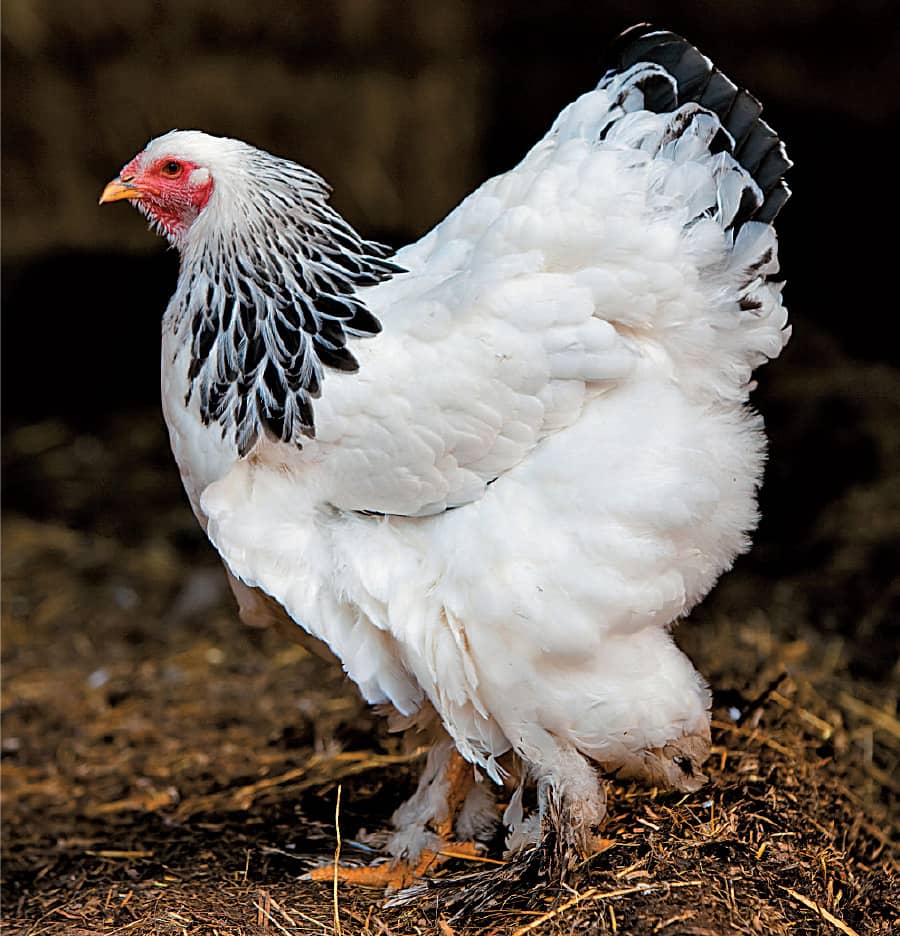
Light Brahma hen
BARNEVELDER
The Barnevelder is one of the most recent breeds accepted into the American Standard of Perfection. It hails from Barneveld, Holland, and is in the Continental class. It is famous for its dark-brown eggshells.
Appearance
The only recognized variety of this breed is the Double-Laced Partridge. Each feather should be reddish brown with a black lacing that has a lustrous, green sheen. The hens weigh 6 pounds (2.7 kg) and should have single combs. There are not many breeders of the Barnevelder and it remains a hard-to-find specimen.
Personality
The hens are independent yet curious and sweet. They are good yard and garden foragers. Barnevelders should be encouraged to lay in nest boxes because their dark-shelled eggs can be difficult to see or find in hidden nests. They are good hens for those starting flocks and produce highly marketable eggs.

Barnevelder
WELSUMMER
The Welsummer, another recent breed, comes from Welsum, Holland, and is also in the Continental class. It is a composite of several breedings between the Partridge Cochin, Partridge Wyandotte, and Partridge Leghorn. The Barnevelder and the Rhode Island Red were added to the mix to create the breed we know today. The Welsummer’s claim to fame comes in the form of its dark-brown eggshell color.
Appearance
The hens weigh approximately 6 pounds (2.7 kg) and have medium-sized single combs. The striking plumage of this breed puts it in the same category as the Silver-Gray Dorking, with a series of colors all over the hen’s body: with a brown and yellow head, a pinkish salmon breast, and the remainder of the bird a beautiful shade of speckled brown.
Personality
The Welsummer lacks broodiness. However, it is a good forager and extremely independent. The breed is a good egg layer, although not likely the most proficient one in your flock. The Welsummer, though a tad skittish, can be tamed so that it is more approachable. These birds are active, ready to bound around the yard in search of worms and grubs in the garden or grass. With time, Welsummers accept new people into their circle, producing strong bonds. Worth a little more work, a Welsummer makes a welcome addition to your flock.
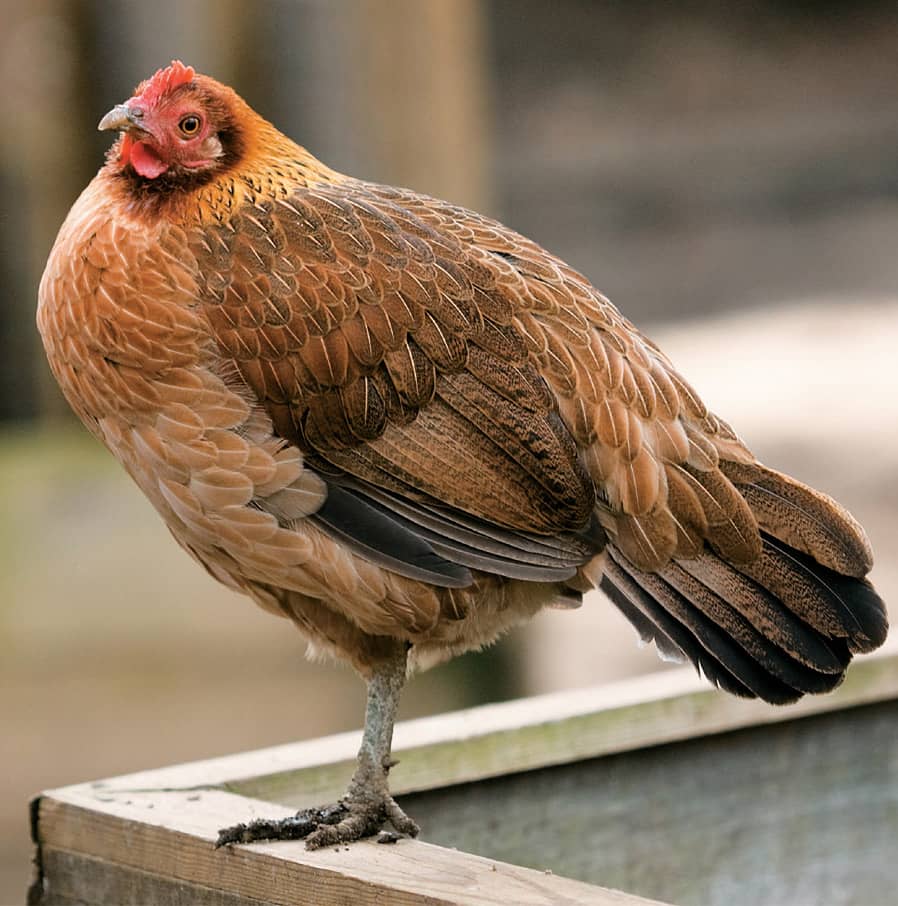
Welsummer
MARANS
The Marans is the newest breed on the block and, therefore, there isn’t much information published about its history or body conformation.
Appearance
They are known for extremely dark-shelled or chocolate-colored eggs. This tends to be an excellent selling point for those eggs. Customers buying mixed or whole dozens often are willing to pay a bit more for the Marans' dark-shelled eggs. Feathered shanks appear to be an important characteristic, but further details on conformation will need to wait.
Personality
These are docile, mellow birds with sweet personalities.
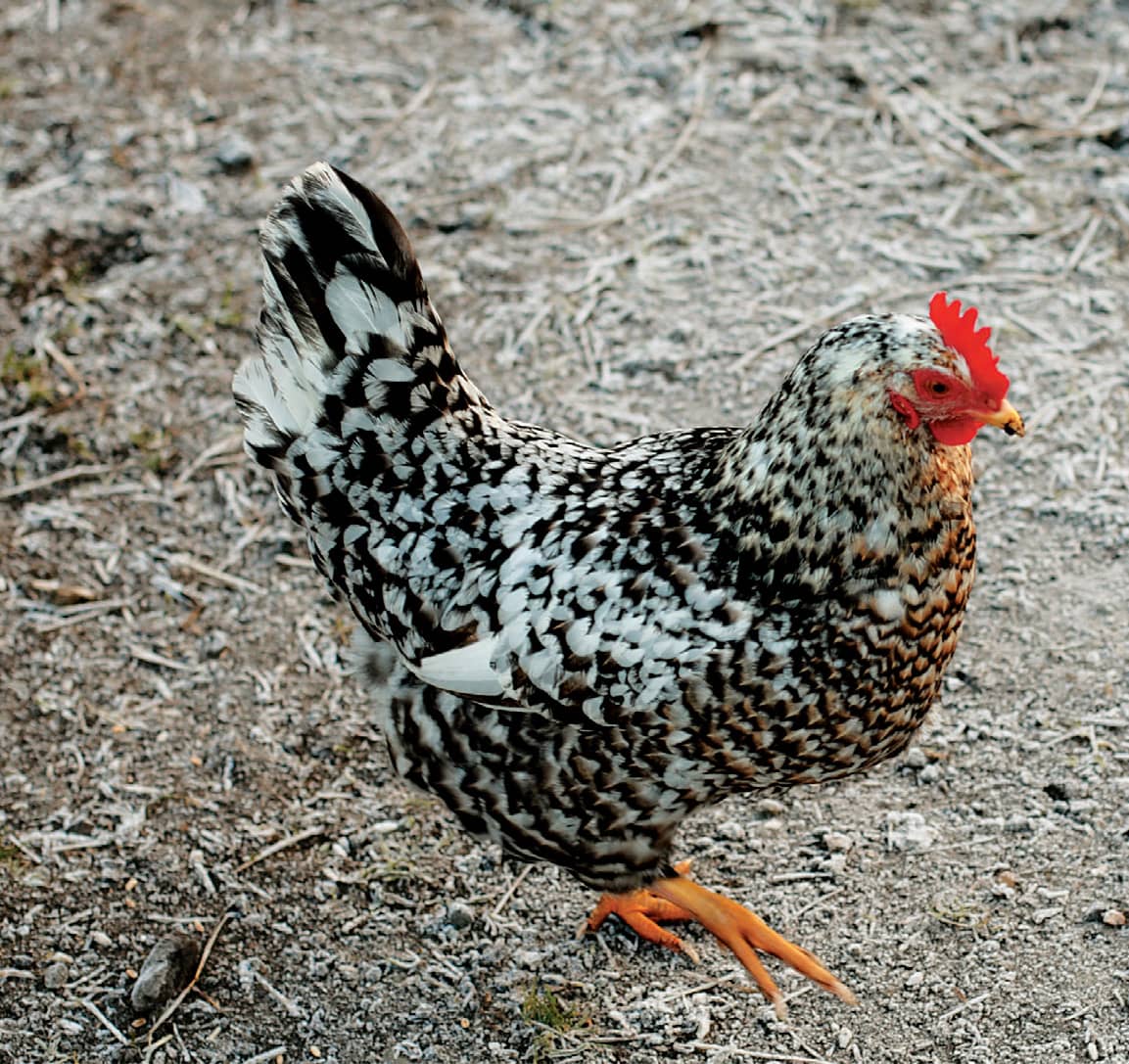
Maran hen
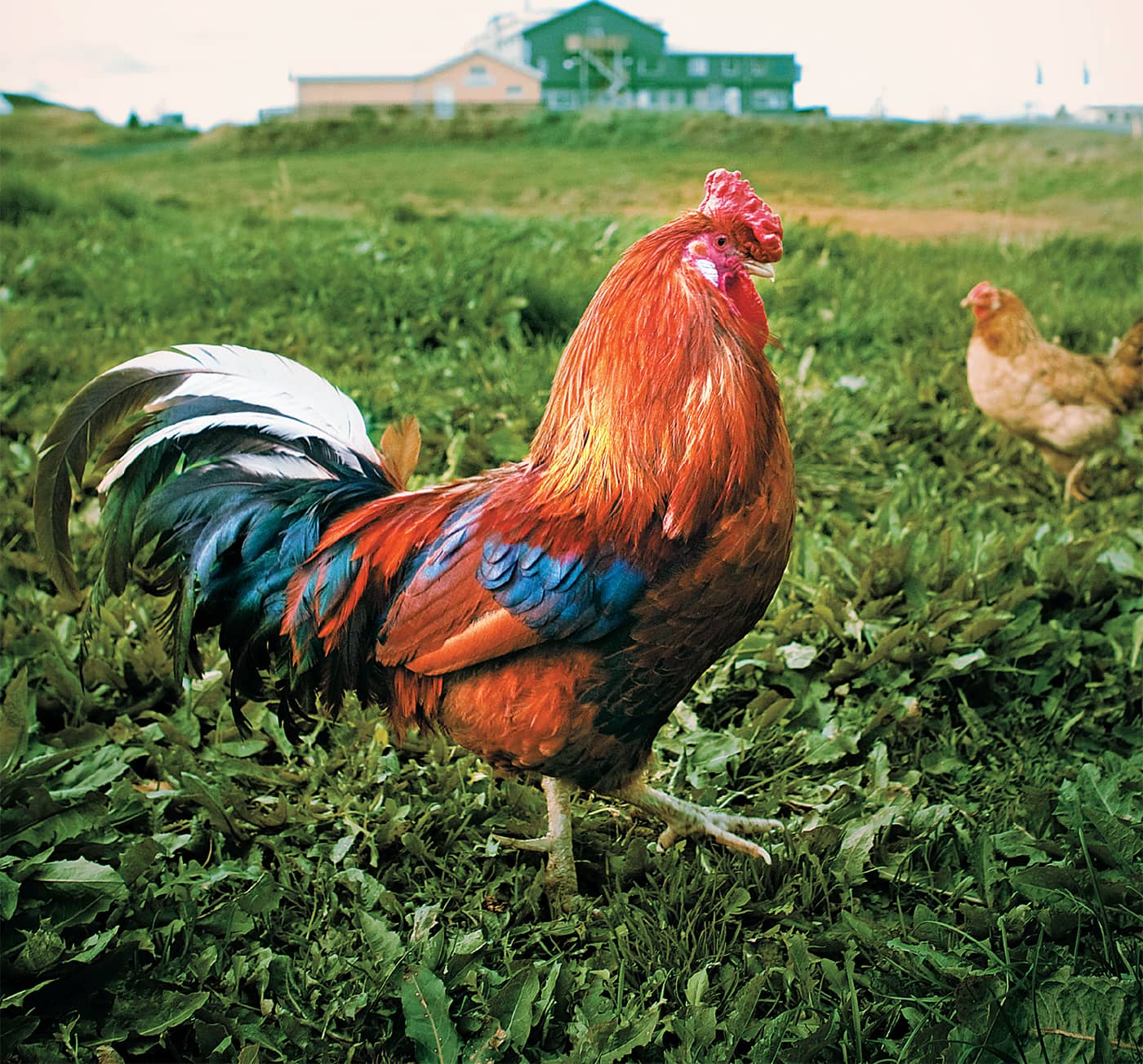
Maran rooster
FINDERS KEEPERS
Remember, all flock members are unique individuals and may not conform to the personalities or descriptions here. Now that you know how the egg forms, perhaps you have more appreciation for the hard work that goes into the process of laying an egg. Go ahead; make deviled eggs, crème brulée, or perhaps a little eggnog. No matter what you prepare, thank your hens every so often with a little extra treat.
This breed guide should help you decide which breeds meet your needs. Perhaps you are interested in a breed not mentioned here. That’s fine. Make sure you find a breeder who can teach you more about that interesting breed. And for breed preservation—if that is part of your goal—always source your birds from reputable breeders. Also, there are many more breeds from which to choose if you delve into the world of bantam (miniature) chickens.
Giving a new hen a safe home in your coop will ensure that you continue to get eggs from happy hens.
